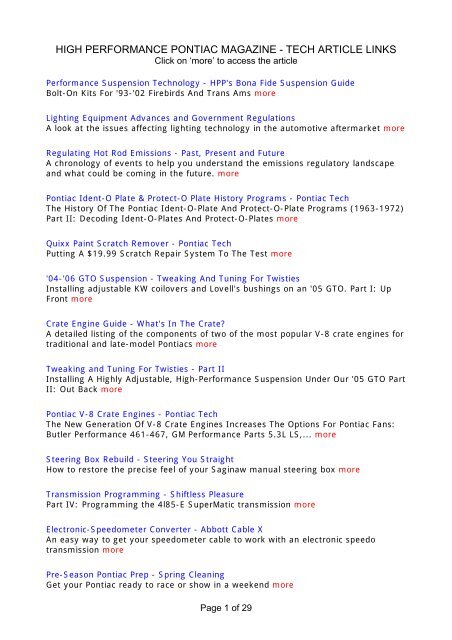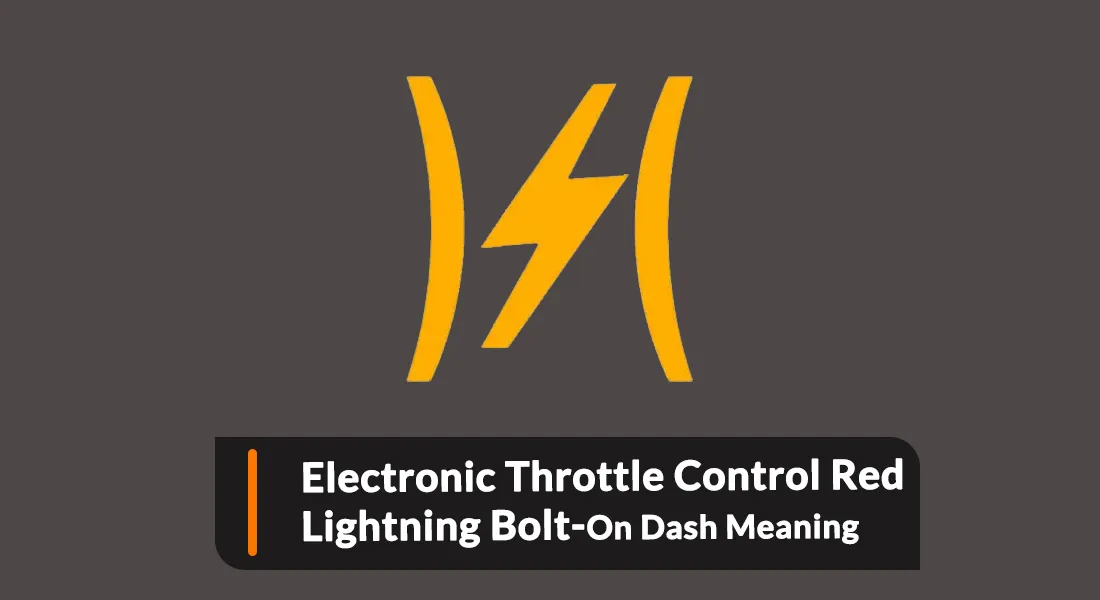Understanding the lightning bolt symbol in your car indicates an issue with the electronic throttle control, requiring immediate attention. This symbol represents a malfunction in the electronic throttle control system, affecting the engine’s performance and requiring diagnosis by a qualified technician.
The electronic throttle control system manages the engine’s power output and responds to the driver’s commands, making it crucial to address any issues promptly. Without proper intervention, a malfunctioning electronic throttle control can diminish the vehicle’s drivability and compromise safety.
Gaining insight into this symbol’s significance can empower drivers to respond effectively to potential issues, ensuring the vehicle’s continued performance and reliability.
What Is The Lightning Bolt Symbol?
The lightning bolt symbol represents the electronic throttle control system in vehicles, which regulates the engine’s throttle opening. Understanding its meaning is crucial for recognizing potential issues with vehicle performance.
Definition Of The Lightning Bolt Symbol
The lightning bolt symbol, also known as the lightning bolt warning light, is a visual indicator that appears on the dashboard of your vehicle. It is specifically related to the Electronic Throttle Control (ETC) system, which regulates the power output of your engine based on the driver’s input.
When the lightning bolt symbol lights up, it is typically accompanied by other warning lights such as the check engine light or the traction control light. This symbol is designed to alert you to a potential issue with the ETC system that requires immediate attention.
Understanding the meaning behind this symbol is crucial, as it can indicate a wide range of problems that may affect the performance and safety of your vehicle. In the following sections, we will explore some common interpretations of the lightning bolt symbol and what they may signify.
Common Interpretations
The lightning bolt symbol on your dashboard can be interpreted in several ways, depending on the specific circumstances and the make and model of your vehicle. Here are some of the common interpretations associated with this warning indicator:
- An issue with the throttle body: The lightning bolt symbol may illuminate if there is a problem with the throttle body, which controls the amount of air entering the engine. This could be due to a malfunctioning throttle position sensor or a blockage in the throttle body itself.
- Faulty electronic sensors: The ETC system relies on various electronic sensors to monitor and adjust the throttle position. If any of these sensors fail or send incorrect signals, it may trigger the lightning bolt symbol.
- Engine misfire or ignition system problems: In some cases, a misfiring cylinder or issues with the ignition system can cause the lightning bolt symbol to appear. This could be due to faulty spark plugs, ignition coils, or fuel injectors.
- Electrical issues: Problems with the electrical system, such as a weak battery or a faulty alternator, can sometimes trigger the lightning bolt symbol. It is important to check the overall health of your vehicle’s electrical components in such cases.
It is essential to note that these interpretations are general guidelines, and the specific cause of the lightning bolt symbol may vary depending on your vehicle’s make, model, and year. Consulting the owner’s manual or seeking professional assistance from a certified mechanic is always advised to accurately diagnose and address the underlying issue.
Now that we have explored the definition and common interpretations of the lightning bolt symbol, it is important to address any concerns promptly. Ignoring the warning sign can lead to further damage and potential safety hazards. Remember, when in doubt, it is always best to consult with a professional to ensure the continued reliability and performance of your vehicle.

Credit: www.facebook.com
Introduction To Electronic Throttle Control
Decipher the enigmatic lightning bolt symbol with an informative guide to Electronic Throttle Control, shedding light on its workings and significance. Gain a comprehensive understanding of this crucial automotive feature in clear and concise terms.
Explanation Of Electronic Throttle Control
In today’s modern vehicles, electronic throttle control (ETC) has become a ubiquitous feature, revolutionizing the way engines function. ETC, also known as drive-by-wire, replaces conventional mechanical throttle systems, allowing for precise control and faster response times. It involves the use of electronic sensors and actuators to communicate between the driver’s foot and the vehicle’s engine management system.
The primary purpose of electronic throttle control is to regulate the airflow into the engine, resulting in improved fuel efficiency, reduced emissions, and enhanced performance. Instead of a physical connection between the accelerator pedal and the throttle plate, ETC relies on electronic signals to control the throttle opening. This digital communication provides several advantages over traditional mechanical systems, including:
Benefits Of Electronic Throttle Control
1. Enhanced responsiveness: With electronic throttle control, the time lag associated with mechanical linkage in traditional systems is eliminated. The result is instantaneous acceleration response, giving drivers a more engaging and dynamic driving experience.
2. Improved fuel efficiency: ETC allows for precise control of the throttle opening, optimizing the air-fuel mixture and improving combustion efficiency. This translates to better mileage and reduced fuel consumption, ultimately saving you money at the pump.
3. Reduced emissions: By precisely controlling the throttle opening, ETC helps minimize unnecessary engine idling and improves the overall efficiency of the combustion process. As a result, harmful emissions such as carbon dioxide and nitrogen oxides are reduced, contributing to a cleaner and greener environment.
4. Integrated safety features: Electronic throttle control systems are equipped with advanced safety features, such as electronic stability control (ESC), traction control, and cruise control. These technologies work in conjunction with ETC to enhance vehicle stability, improve handling, and provide a safer driving experience.
5. Adaptive control: ETC systems are capable of adapting to different driving conditions and individual driving styles. The engine management system can analyze real-time data from various sensors to optimize throttle response, ensuring smooth operation whether you’re cruising on the highway or maneuvering through city traffic.
As automotive technology continues to evolve, electronic throttle control has become an integral part of modern vehicles. Its ability to provide precise control, improved performance, and enhanced fuel efficiency makes it a key component in shaping the future of automotive engineering.
Causes Of The Lightning Bolt Symbol
Sure, I can help you with that. Here is the HTML code for the introductory paragraph about the causes of the lightning bolt symbol:“`htmlThe lightning bolt symbol can often be a source of confusion for many car owners. Understanding the causes of this symbol appearing on your dashboard can help in identifying potential issues with the electronic throttle control system. Below, we’ll explore two common causes of the lightning bolt symbol and what they signify for your vehicle’s performance.
Malfunctioning Throttle Position Sensor
Issues With The Electronic Throttle Control System
A malfunctioning throttle position sensor can trigger the lightning bolt symbol on your dashboard. This sensor is responsible for monitoring the position of the throttle and sending this information to the vehicle’s engine control unit. If the sensor fails or provides inaccurate readings, it can disrupt the communication between the throttle and the engine, leading to performance issues and the appearance of the lightning bolt symbol.
The electronic throttle control system operates using complex sensors and actuators to control the engine’s throttle electronically. Any faults within this system, such as a malfunctioning throttle body, wiring issues, or electronic control module problems, can trigger the appearance of the lightning bolt symbol. These issues may result in a lack of power, rough idling, or the vehicle going into limp mode, where the throttle response is limited and acceleration is reduced.
“`By providing clear and concise information about the causes of the lightning bolt symbol, car owners can be better equipped to address these issues and ensure the proper functioning of their electronic throttle control system.Diagnosing The Lightning Bolt Symbol
The lightning bolt symbol on your dashboard could be indicative of a problem with the electronic throttle control system. This issue may lead to reduced engine power and potentially hazardous driving conditions, so it is crucial to diagnose and address it promptly.
Understanding Obd-ii Codes
When diagnosing the lightning bolt symbol, one valuable resource is the On-Board Diagnostics II (OBD-II) system. This standardized diagnostic tool provides access to trouble codes, illuminating the underlying issues affecting your vehicle’s performance. OBD-II codes offer valuable insights into the specific nature of the problem, enabling a more targeted resolution.
Using Diagnostic Tools
Utilizing diagnostic tools such as code readers or scan tools can streamline the process of identifying the root cause of the lightning bolt symbol. These tools facilitate the retrieval and interpretation of OBD-II codes, empowering you with the information needed to make informed decisions regarding repairs or maintenance.
Common Fixes For The Lightning Bolt Symbol
When the lightning bolt symbol appears on your vehicle’s dashboard, it indicates a problem with the electronic throttle control system. This system is responsible for regulating the engine’s power and maintaining a smooth driving experience. Ignoring this warning can lead to serious issues and even a complete loss of engine power. Fortunately, there are common fixes that can help you resolve the problem and get back on the road safely. In this article, we will explore two effective solutions: throttle body cleaning and replacing faulty components.
Throttle Body Cleaning
The throttle body is an essential part of the electronic throttle control system. It regulates the amount of air entering the engine, controlling the engine’s speed and power output. Over time, carbon buildup can accumulate on the throttle body, affecting its performance and triggering the lightning bolt symbol to appear on the dashboard. Cleaning the throttle body can often resolve this issue and improve the overall functioning of the electronic throttle control system.
- Start by disconnecting the negative battery cable to ensure your safety.
- Locate the throttle body. It is typically positioned on the intake manifold and connected to the air intake tube.
- Remove the air intake tube and carefully detach the electrical connectors from the throttle body.
- Using a throttle body cleaner and a clean cloth, gently remove the carbon deposits from the throttle body. Be thorough but avoid using excessive force that could damage the delicate components.
- After cleaning, reassemble the throttle body, ensuring all connections are secure and tight.
- Finally, reconnect the negative battery cable and start your vehicle to check if the lightning bolt symbol has disappeared.
Replacing Faulty Components
In some cases, the lightning bolt symbol may indicate a faulty component within the electronic throttle control system. These components may include the throttle position sensor, accelerator pedal position sensor, or electronic control module. If throttle body cleaning does not resolve the issue, it is recommended to consult a professional mechanic to diagnose and replace any faulty components.
- Visit a trusted mechanic who specializes in electronic throttle control systems.
- Explain the problem and provide them with any error codes generated by the vehicle’s onboard diagnostic system.
- The mechanic will perform a thorough inspection, testing each component to identify the faulty one.
- If a faulty component is identified, the mechanic will replace it with a new, genuine part.
- After the replacement, the mechanic will reset any error codes and ensure all connections are secure.
- Once the repair is complete, the vehicle should be tested to ensure the lightning bolt symbol no longer appears.

Credit: www.yumpu.com
Preventive Measures For Electronic Throttle Control Issues
Preventive measures are essential to ensure the smooth functioning of electronic throttle control systems, which play a crucial role in modern vehicles. By taking proactive steps to maintain and monitor this system, you can prevent potential issues from arising. In this section, we will discuss some preventive measures for electronic throttle control issues and how they can help you avoid costly repairs or breakdowns.
Regular Maintenance
Maintaining your electronic throttle control system is vital to prevent issues that could impact your vehicle’s performance. Regular maintenance practices include:
- Performing routine inspections of the throttle body for any signs of dirt, carbon buildup, or debris that may hinder its operation.
- Cleaning the throttle body using an appropriate throttle body cleaner and a soft brush to remove any accumulated dirt or carbon deposits.
- Checking and replacing the throttle position sensor (TPS) if necessary, as a faulty TPS can cause irregular throttle response.
- Inspecting the wiring harness and connectors for any signs of wear, corrosion, or damage, and repairing or replacing them as needed.
| Frequency | Task |
|---|---|
| Every 30,000 miles | Inspect throttle body and clean if necessary |
| Every 60,000 miles | Check and replace the throttle position sensor (TPS) |
| As needed | Inspect and repair/replace wiring harness and connectors |
Driving Habits To Avoid
Your driving habits can also have an impact on the performance of your electronic throttle control system. Here are some habits to avoid:
- Avoid abrupt and excessive acceleration or deceleration, as this can put strain on the throttle system.
- Do not “ride” the throttle. Instead, maintain a steady speed whenever possible to reduce unnecessary stress on the throttle components.
- Minimize the use of cruise control in hilly terrains or during adverse weather conditions, as it can lead to constant adjustments by the throttle system, increasing the chances of issues.
- Avoid driving through deep water or flooded areas, as water ingress can damage the throttle system.
By following these preventive measures and incorporating them into your regular vehicle maintenance routine, you can ensure the longevity and optimal performance of your electronic throttle control system.

Credit: taxiwiz.com
Conclusion
Understanding the lightning bolt symbol and electronic throttle control is crucial in today’s automobile technology. By deciphering its meaning, drivers can identify and address potential issues effectively. This blog post has provided an in-depth look into the electronic throttle control system and its importance.
By boosting your knowledge about this symbol, you can ensure a smoother and safer driving experience. Stay informed and stay in control.


